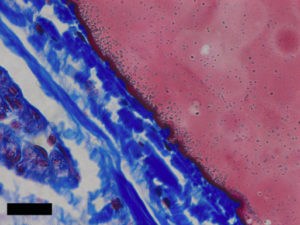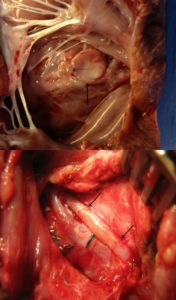
A close-up view of the adhesive (pink) interacting with collagen tissue (blue). Images courtesy Karp Lab.
Congenital heart defects occur in nearly 1 in 100 births, and those that require treatment are plagued with multiple surgeries to deliver or replace implants that do not grow along with the child. Currently, therapies are invasive and challenging due to an inability to quickly and safely secure devices inside the heart. Sutures take too much time to stitch and can cause stress on fragile heart tissue, and the available clinical adhesives are subpar.
“Current glues are either toxic or easily washout in the presence of blood or react immediately upon contacting water,” says Pedro del Nido, MD, chief of Cardiac Surgery at Boston Children’s Hospital and senior co-author of the study. “The available options also tend to lose their sticking power in the presence of blood or under dynamic conditions, such as in a beating heart.”
In the preclinical study, researchers from Boston Children’s, Brigham and Women’s Hospital and the Massachusetts Institute of Technology (MIT) developed a nontoxic, biologically inspired adhesive that could rapidly attach biodegradable patches inside a beating heart—in the exact place where the hole occurs, such as with ventricular heart defects.

The waterproof, light-activated adhesive can successfully secure biodegradable patches to seal holes in a beating heart (top), as well as seal blood vessels (bottom).
“This adhesive platform addresses all of the drawbacks of previous systems in that it works in the presence of blood and moving structures,” says del Nido. “It should provide the physician with a completely new, much simpler technology and a new paradigm for tissue reconstruction to improve the quality of life of patients following surgical procedures.”
“To our knowledge this is the first demonstration that an adhesive can bond to wet tissues and seal them without being impacted by the presence of blood,” says Jeffrey Karp, PhD, of the Division of Biomedical Engineering at Brigham and Women’s, the study’s co-senior author. “Importantly, we showed that the tissue glue can seal holes in high-pressure dynamic tissues including blood vessels and myocardium.”
Moreover, because the glue’s adhesive abilities are activated with ultraviolent (UV) light, it can provide an on-demand, anti-bleeding seal within five seconds of UV light application when applied to high-pressure large blood vessels and cardiac wall defects.
The researchers note that their waterproof, light-activated adhesive will be useful in reducing the invasiveness of surgical procedures, as well as operating times, in addition to improving heart surgery outcomes.
“We are delighted to see the materials we developed being extended to new applications with the potential to greatly improve human life,” says Robert Langer, ScD, professor of chemical and biomedical engineering at MIT and a co-author on the study.
The adhesive technology (and other related platforms) has been licensed to a start-up company, Gecko Biomedical, based in Paris. The company has raised 8 million Euros in their recently announced Series A financing round and expects to bring the adhesive to the market within two to three years.







